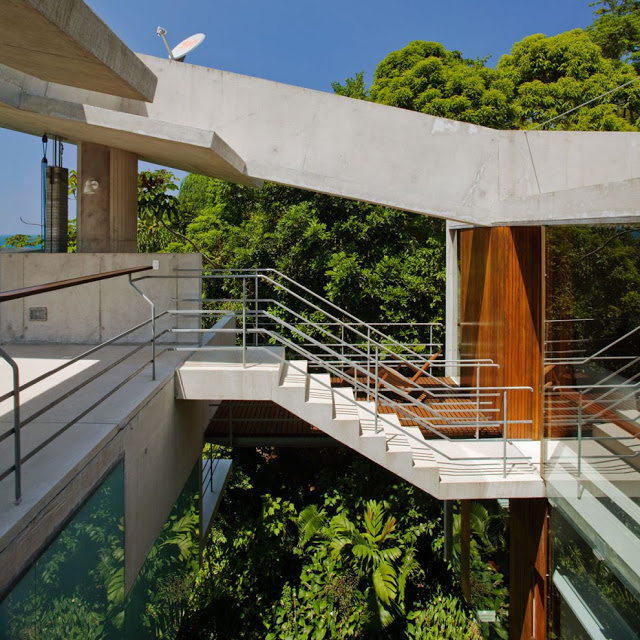Brazilian architectural firm SPBR Architects was brought to the forefront of American architects last year when firm head and founder Angelo Bucci received a 2011 AIA Honorary Fellowship for design. The honorary fellowship is awarded to non–U.S. citizens or residents who practice mostly outside of the AIA domain, for their contributions to the architectural profession.
Bucci’s achievements include a range of built projects. SPBR focuses on meaningful projects with a coherent structure that maintains logical, seamless flow between interior and exterior spaces.
In the recent years before Bucci received the AIA award, SPBR had completed two residential projects that remain, arguably, its most well known and significant. The House in Ubatuba, near Tenório’s beach in São Paulo, sits on a hard and steep hill surrounded by trees, all of which are protected by environmental regulations.
The house, completed in 2009, appears to float among the trees. Looking at it from the beach, a wood and concrete side peaks through the top of the tree-covered hill, but its connection to the ground is unclear. From inside looking out, views of the sea, beach, and trees dominate—it is a modernist, luxury treehouseBut the structure does, of course, touch the ground: three columns of reinforced concrete support four steel beams that allow slabs to hang from above. The top terrace is at street level, and a bridge connects house to street, further emphasizing a sense of isolation amongst the trees. Another bridge leads to a rooftop pool and the house’s second volume.
Inside, large, open spaces are completed with a strategic mix of furnishings—including a wicker couch and wing-back chair in one living space, and a slip-covered sofa in another. Walls are bare, showcasing the building’s materials. Creams, natural-looking woods, white, and tans create a soothing ambience. Minimalism and a traditional beach-home feel intertwine; the starkness of minimalism is made comfortable.
Unlike the Ubatuba house, for SPBR’s 2008 Santa Teresa project, one volume sits firmly on high ground, while an adjacent and perpendicular volume floats one story above its lower ground. In this historical neighborhood in Rio de Janeiro, the SPBR house is on one of the highest points in the town, providing views of the center of Rio, the Sugar Loaf, and Guanabara Bay.
The living room is on the higher level with kitchen in an open space below, and bedrooms and office on the lower level. The facades of each volume are planned around sun heat and views. The lower portion is closed on north and south sides, while the east and west facades are open, the former to a garden. The upper volume is conversely closed on the east and west sides to avoid sun heat but glass window walls on the north and south showcase views of the downtown area and Guanabara Bay and Pão de Acucar.
SPBR explores a wide variety of interests beyond unique residential projects. The firm received a Holcim Silver Award in 2008 for its Pontificial Catholic University in Rio Mediatheque in Rio de Janeiro, an energy-efficient media library. Bucci, who led the project, reduced energy consumption through “passive design elements including appropriate orientation, heat insulation, shaded windows, natural ventilation and natural lighting,” according to the Holcim Foundation—no small feat considering the climate control required for book and media preservation in the space.
More recently, SPBR was one of twelve firms asked by former Miami Art Museum director Terence Riley to participate in the exhibition “The Street” in the fourth annual Shenzhen and Hong Kong Bi-City Biennale of Urbanism\Architecture. Architects from five continents developed facades that showcased their design philosophies in late 2011/early 2012.
Prior to founding SPBR in 2003, Bucci was a partner at Arquitetura Paulista in 1989–1994 and a founding partner at MMBB Architects from 1996 to 2002. He continues to focus on both academic and professional pursuits. He is a lecturer at the Universidade de São Paulo in Brazil, and has been a visiting professor or lecturer at universities around the world, including MIT, Harvard’s Graduate School of Design, Princeton, and University of California, Berkeley in the US, Università IUAV di Venezia in Italy, Torcuato Di Tella in Argentina, Universidad de Cuenca in Ecuador and Andres Bello in Chile.









